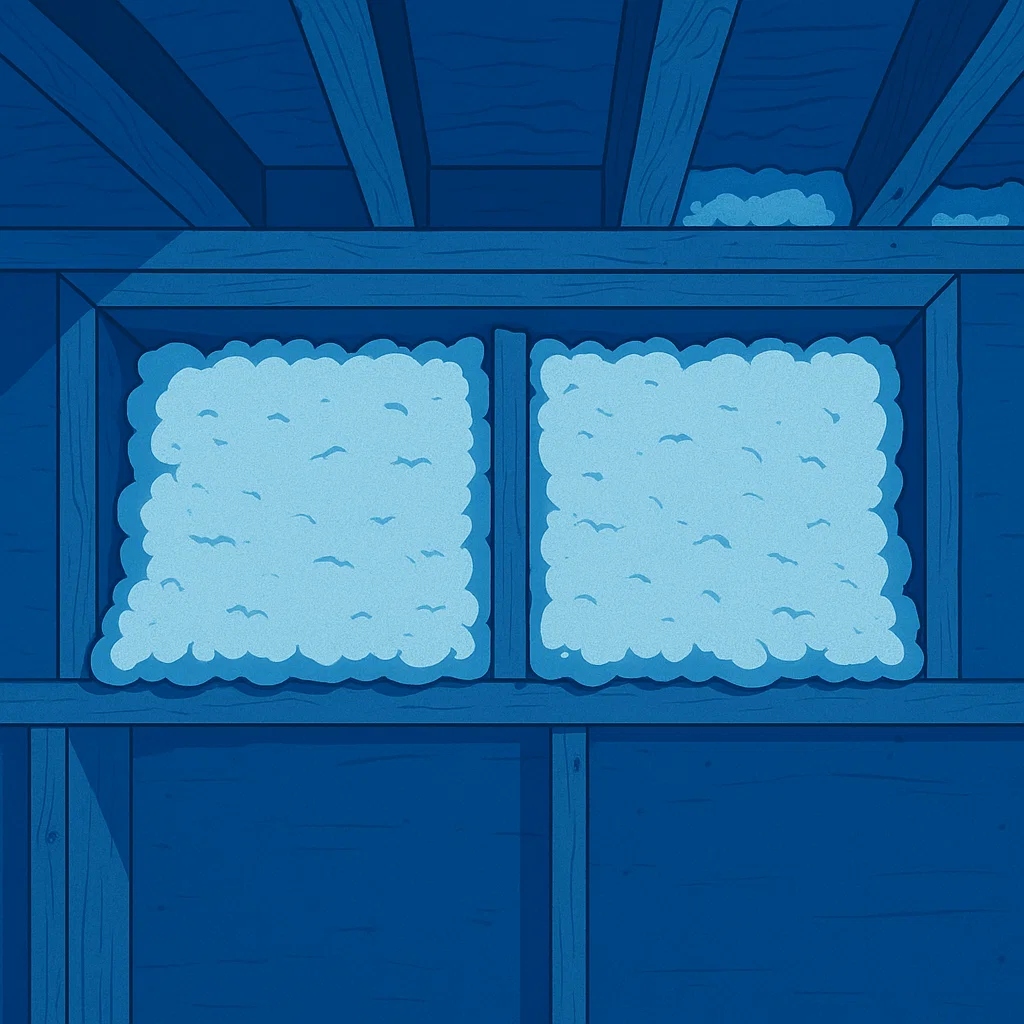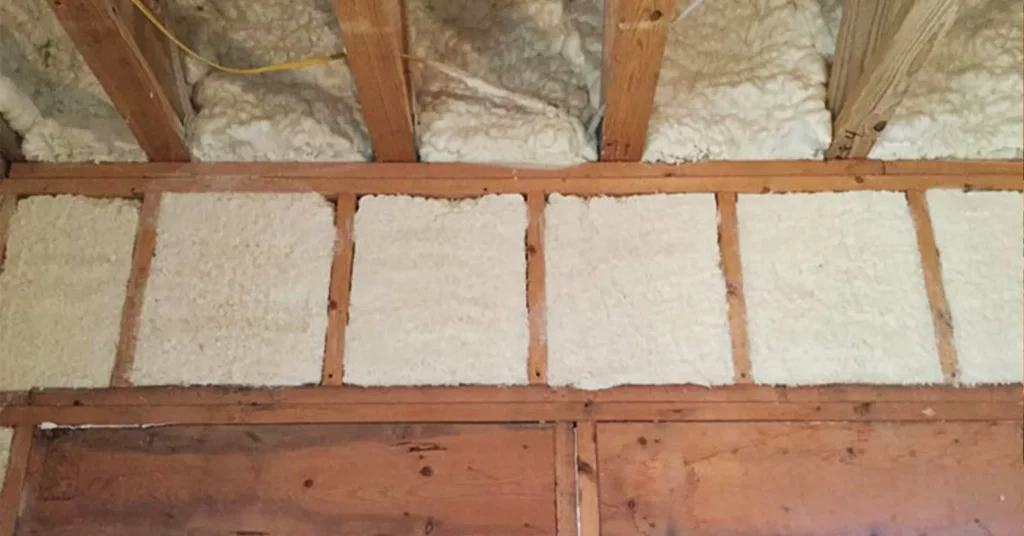Understanding Rim Joists and Their Importance
A rim joist, also known as a band joist, is the board that runs along the outer edge of a floor system, capping the ends of the floor joists. It sits on top of the foundation wall and supports the structure above. Because it’s positioned at the intersection of the floors and exterior walls, it’s a common area for air leaks and heat loss if not properly insulated.
Positioned above the sill plate and resting on the concrete wall of the foundation, rim joists play a crucial role in maintaining your home’s structural integrity. However, rim joists are notorious for being a significant source of heat loss, especially in cold climates like Winnipeg. Due to their location, they are susceptible to air infiltration, moisture buildup, and air leaks, which can compromise your home’s energy efficiency and comfort. Proper rim joist insulation is essential to prevent these issues and maintain a consistent indoor temperature.
Why Rim Joists Are a Problem Area
Cold Air Infiltration and Moisture Buildup
Rim joists are often exposed to humid interior air, which can lead to condensation when it meets the cold surfaces of the joist area. This moisture accumulation can result in mold growth, mildew growth, and even structural damage over time. Additionally, gaps and cracks in the rim joist cavity can allow cold air to infiltrate, leading to air leakage and drafts.
Impact on Energy Bills and Comfort
Uninsulated or poorly insulated rim joists can significantly impact your home’s energy efficiency. The heat transfer through these areas forces your heating system to work harder, increasing material costs and energy bills. Moreover, the resulting drafts and cold floors can make living spaces uncomfortable, particularly during Winnipeg’s harsh winters.
Common Signs of Under-Insulated Rim Joists
- Drafts near baseboards or along the floor
- Cold floors above the basement or crawl space
- Visible condensation or signs of mold growth on the rim joist area
- Increased energy bills without a clear cause
Rim Joist Insulation Options: Pros and Cons
Spray Foam Insulation
Spray foam insulation is a popular choice for insulating rim joists due to its excellent air sealing and moisture resistance properties.
Closed-cell vs Open-cell Spray Foam
- Closed-cell spray foam: Offers a high R-value per inch, acts as a vapor barrier, and provides structural support.
- Open-cell spray foam: More affordable but less effective as a moisture barrier and has a lower R-value.
Pros:
- Creates an effective air barrier, reducing air infiltration
- Acts as a vapor barrier, preventing moisture buildup
- Fills irregular spaces and gaps, ensuring comprehensive coverage
Cons:
- Higher material costs compared to other insulation types
- Requires professional installation due to the need to wear protective gear and handle organic chemical compounds derived from petroleum
- Some spray foam products may emit a slight odor during the curing process
Fiberglass Batts
Fiberglass insulation is a traditional method made from extremely fine glass fibers. It’s commonly used due to its affordability and ease of installation.
Pros:
- Low cost and widely available
- DIY-friendly for those comfortable with home improvement projects
Cons:
- Air permeable, allowing air flow and reducing effectiveness
- Susceptible to moisture accumulation, leading to mold growth
- Can cause skin irritation; it’s essential to wear protective gear during installation
Rigid Foam or Board Foam Insulation
Rigid foam insulation (as known as board foam insulation), which includes extruded polystyrene foam (XPS) and expanded polystyrene board (EPS), offers a durable solution for rim joist insulation.
Pros:
- High R-value per inch, enhancing energy efficiency
- Resistant to moisture, reducing the risk of mildew growth
- Provides a stable surface for finishing materials
Cons:
- Requires precise cutting and fitting, which can be challenging in tight spaces
- Needs additional sealing at joints to prevent air leakage
Mineral Wool
Mineral wool, also known as rock wool, is made from natural stone and offers excellent fire resistance.
Pros:
- Non-combustible and can withstand high temperatures
- Resistant to moisture and does not promote mold growth
Cons:
- Does not provide an effective air barrier on its own
- Requires additional materials to ensure comprehensive air sealing
Best Rim Joist Insulation for Manitoba Homes
In Winnipeg’s cold climate, selecting the right rim joist insulation materials is crucial. The combination of extreme temperatures and potential for moisture buildup necessitates an insulation solution that offers both thermal resistance and moisture control.
Closed-cell spray foam stands out as the best rim joist insulation for Manitoba homes. Its high R-value, excellent air sealing, and moisture resistance make it ideal for preventing heat loss and maintaining indoor comfort.
Comparison Table:
| Insulation Material | R-Value per Inch | Air Sealing | Moisture Resistance | DIY-Friendly |
|---|---|---|---|---|
| Closed-Cell Spray Foam | High | Excellent | Excellent | No |
| Open-Cell Spray Foam | Moderate | Good | Moderate | No |
| Fiberglass Batts | Low | Poor | Poor | Yes |
| Rigid Foam Board | High | Good (with sealing) | Good | Moderate |
| Mineral Wool | Moderate | Poor | Good | Yes |
Professional vs. DIY: What You Need to Know
While some joist insulation methods, like installing fiberglass batts, can be DIY-friendly, others, such as applying spray foam insulation, require professional expertise.
Challenges with DIY Insulation:
- Ensuring complete air sealing in irregular or tight spaces
- Handling spray foam kits safely, including the need to wear protective gear
- Complying with local building codes and regulations
Given these challenges, it’s advisable to consult professionals like Above All Insulation to ensure proper installation and optimal performance.
Above All Insulation’s Recommended Solution
At Above All Insulation, we recommend using 2 inches of closed-cell spray foam for rim joist insulation. This approach provides a seamless air barrier, acts as a vapor barrier, and offers superior thermal resistance.
For homeowners seeking additional insulation, we offer a hybrid solution combining spray foam with rigid foam products. This method enhances the overall R-value and ensures comprehensive coverage, particularly in areas with tight spaces or complex configurations.
Our team ensures that all installations are performed safely, adhering to best practices and using high-quality spray foam products to deliver long-lasting results.
Cost vs. Value: What You Can Expect in Manitoba
Investing in foam insulation for your rim joists can lead to significant energy savings and improved home comfort. While the initial material costs for spray foam insulation may be higher, the long-term benefits often outweigh the expenses.
Estimated Costs:
- Closed-cell spray foam: Higher upfront cost but offers superior performance
- Fiberglass batts: Lower cost but may require replacement sooner due to moisture accumulation
- Rigid foam insulation: Moderate cost with good durability
Additionally, Manitoba homeowners may be eligible for rebates or incentives through programs like Efficiency Manitoba, further offsetting the investment.
Choosing the Best Rim Joist Insulation
When it comes to insulating your home, few areas are as critical—and often overlooked—as the rim joist cavity. After comparing all major rim joist insulation materials, it’s clear that closed-cell spray foam insulation delivers the best overall performance. Closed-cell spray foam stands out for its superior R-value, ability to act as both an air barrier and vapour barrier, and its performance in tight, irregular spaces. Unlike air-permeable options like fiberglass batts or rigid foam board—which often require additional sealing—spray foam creates a seamless, durable barrier that blocks air leaks, prevents moisture buildup, and stops heat loss at the rim joist cavity.
While options like rigid foam insulation and mineral wool offer some benefits, none match the comprehensive protection of professionally applied spray foam insulation. If you’re insulating basement rim joists or retrofitting an older home, investing in closed cell spray foam—installed by trusted experts like Above All Insulation—is the most effective way to reduce drafts, improve energy efficiency, and protect against mould growth and moisture damage year-round.
At Above All Insulation, we’re committed to providing expert insulation solutions tailored to your Winnipeg home. Our insulation team ensures safe, efficient, and effective installation, helping you enjoy a more comfortable and energy-efficient home year round. Contact us today to get a free insulation or rim joist insulation quote before the next cold season hits. Insulation not only improves energy efficiency in winter, but in summer too!
Frequently Asked Questions (FAQ)
Q: Can I insulate my rim joists myself?
A: While it’s possible to install certain types of insulation, like fiberglass batts, as a DIY project, materials like spray foam require professional installation due to safety considerations and the need for specialized equipment.
Q: Is spray foam safe for rim joists?
A: Absolutely! When applied correctly by professionals, spray foam insulation is safe and effective. It’s essential to allow the foam to cure properly and ensure proper ventilation during installation.
Q: How much heat is lost through rim joists?
A: Uninsulated rim joists can contribute significantly to heat loss, leading to increased energy bills and reduced indoor comfort.
Q: Will rim joist insulation help with pests or moisture?
A: Proper rim joist insulation, especially with closed-cell spray foam, can seal gaps and prevent moisture buildup, reducing the risk of mold growth and pest infestations.

